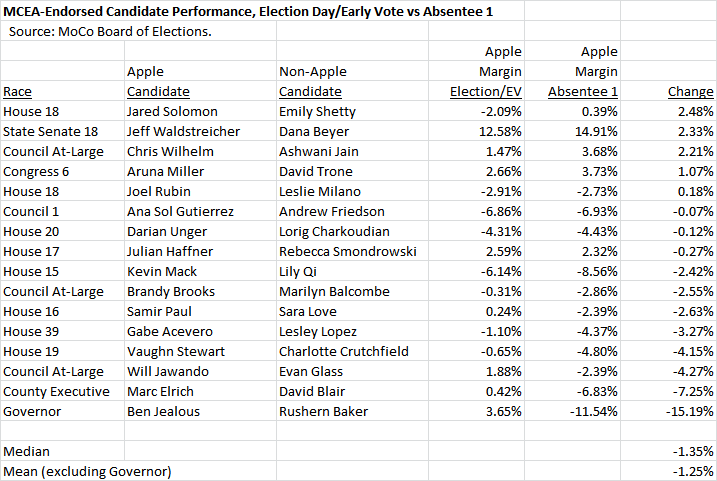By Adam Pagnucco.
All eyes in political MoCo are on the County Executive race, which will be decided by absentee and provisional ballots. After the first absentee canvass, Marc Elrich’s lead over David Blair has declined from 492 votes to 149 votes, guaranteeing an absolute squeaker of a finish. Lots of folks are asking why. A preliminary analysis of absentee voting data suggests one reason: for the most part, candidates endorsed by MCEA, of whom Elrich is one, are performing slightly less well in absentee voting than in early voting and election day voting.
The Montgomery County Education Association (MCEA), which represents MCPS teachers, has historically been the most powerful interest group in MoCo elections. Its political program has combined mail and poll coverage where its mighty Apple Ballot is distributed. This year, its mail program has been partially diverted to the Governor’s race (where the union helped pay for three mailers on behalf of Ben Jealous) and Congress District 6 (where the union sent three mailers for Aruna Miller). Its remaining mailers were one for its State Legislative District 16 endorsees (one of whom was teacher Samir Paul), one for its Council At-Large endorsees (one of whom was teacher Chris Wilhelm) and one with the Apple Ballot itself. The latter mailer was the only one to include Marc Elrich, who was endorsed late. In past years in which races for Governor and Congress were not an issue, MCEA’s mail program was entirely focused on state legislative and county races.
Alterations to the mail program may explain variations in absentee ballot voting. People who vote early, on election day and through provisional ballots may encounter Apple Ballot poll coverage. And it’s not just MCEA who distributes it; candidates who are featured on it often distribute it too. But absentee voters do not go to a polling place. They must be contacted through other means. As stated above, MCEA’s mailers were drawn into races for Congress and Governor and if the union has a robust digital program, we have not seen it. All of this means that absentee voters in General Assembly and county-level races are less likely to be influenced by the Apple.
The table below shows sixteen close performances in county races between Apple-endorsed and non-Apple candidates. (We excluded incumbents to remove any incumbent effect on absentee voting.) In each race, the margin between the two in election and early voting results is shown alongside the margin in the first absentee canvass. (Both sets of results are unofficial and there will be another absentee canvass.) In eleven of these sixteen races, Apple-endorsed candidate performance declined in absentee voting.
Now some of these races have other things going on. In Congress District 6, Aruna Miller benefited from MCEA’s three mailers and her performance actually rose a tiny bit among absentees. In the gubernatorial race, a clear outlier, Rushern Baker may have benefited from the Washington Post’s strong endorsement. (This year, the Post did not endorse in Congressional or state legislative races.) David Blair got not one, but two Post endorsements. Elrich’s late endorsement from MCEA handicapped his ability to publicize it, which may have impacted absentee voters. And so on.
The Apple Ballot is arguably the best endorsement in the county. Blair would already have won the Executive race if Elrich had not received it. But the data above, however tentative it is, suggests a pattern: the Apple has been slightly less effective in absentee voting. The median performance drop is 1.4 points. The mean performance drop excluding the outlier race for Governor is 1.3 points. So let’s round it in rough terms to a point-and-a-half decline. That’s not enough to affect most races but it is having an impact on the razor-thin contests for County Executive and House 16. MCEA should consider this in designing its future political programs.

